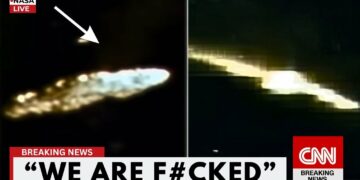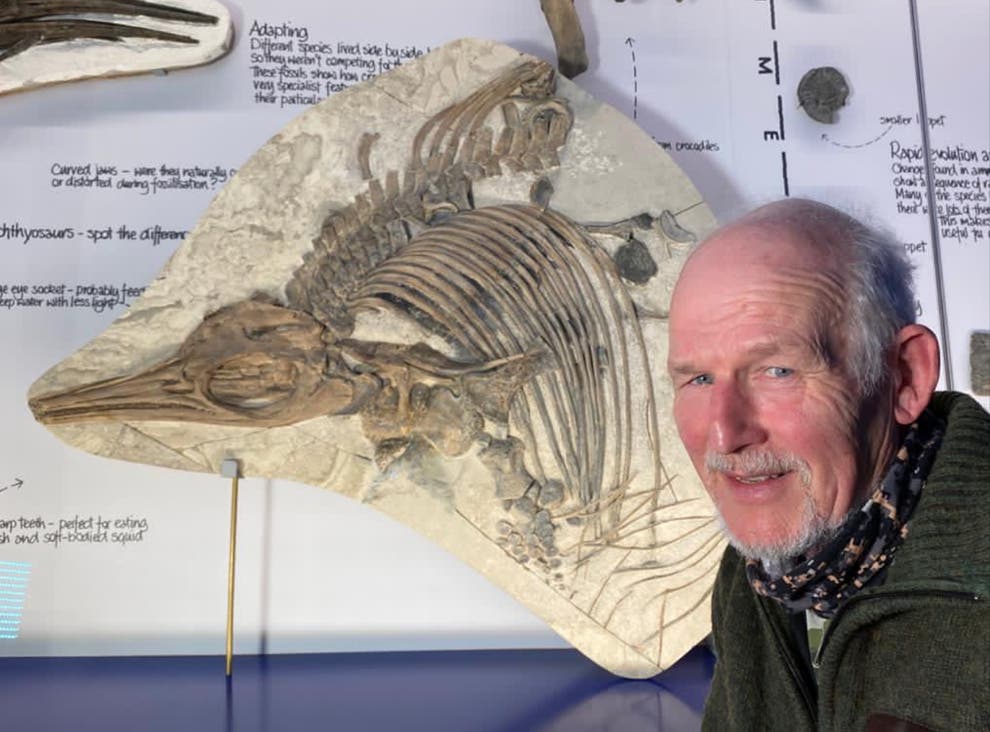Three Atlas just shifted its orbit against gravity, raising serious concerns among scientists. Before the news of its discovery reached Earth, 3I Atlas had already rewritten a law of nature. Spectra revealed nickel where there should be dust, metal where there should be ice—a Manhattan-sized visitor bleeding a human alloy in a place where industry does not exist. It wasn’t the arrival that unsettled scientists. It was recognition. Something out there was doing metallurgy in the dark. A city in the dark between worlds. In the deep, airless quiet between Mars and the Sun. Something the size of Manhattan is shedding metal.
Astronomers first logged it as a fast-mover: an interstellar object slicing into our system on a cold, efficient trajectory. They named it 3I Atlas—the third known interstellar visitor unbound to the Sun. Not born here, not shaped here, not ours. It should have behaved like a comet. That was the expectation. That is always the expectation. A frozen body gets close to heat, ice flashes to vapor, pressure builds, and the thing starts bleeding out in a curved, glowing tail that stretches away from the Sun like a banner. We’ve watched that performance all our lives. No one questioned the script.
In late July, the Hubble Space Telescope tracked it and produced an image that made observers uncomfortable—for reasons they could not immediately describe. There was no gorgeous sweeping tail being blown backward by solar radiation. No long white veil curling into space. Instead, there was a concentrated jet, a hard stream of expelled mass firing in exactly the wrong direction. Rather than peeling away from the Sun, the flow of material was aimed toward it. That jet wasn’t light and pretty. It was dense. According to the reported analysis, it carried roughly 330 pounds of material every second: carbon dioxide, water, trace cyanide, nickel—and no iron. It wasn’t drifting behind 3I Atlas like a bridal train. It was almost like thrust. It was pointed.
When the Keck 2 telescope in Hawaii got time on 3I Atlas in August, the data came back with something nobody had language ready for. Spectral work suggested that 3I Atlas was giving off nickel at about 4 grams per second. But again, no sign of iron riding with it. That ratio is wrong. In every normal comet ever studied—including the two known before 3I Atlas that came from outside the solar system—nickel and iron show up together in broadly comparable amounts. They are partners. They condense out of the same primordial furnaces. You do not get one without the other.
This is where Harvard astrophysicist Avi Loeb stepped forward and said the quiet part out loud. He told the New York Post that the plume coming off 3I Atlas appears consistent with nickel tetracarbonyl—a highly specific nickel-carbonyl compound that humans only ever see in industrial metal processing, including aerospace surface hardening. He didn’t hedge. This was never observed for any other object. He said this compound does not come from natural comet behavior—not from any comet on record. The alloy that shouldn’t exist out here. Nickel tetracarbonyl should not be coming out of a comet near Earth. This compound shows up in controlled conditions: high-pressure, carbon-monoxide-rich environments where nickel binds with carbon and oxygen in a way that lets it be transported, deposited, used to plate or reinforce metal surfaces. It is toxic, volatile, engineered, and useful. It’s part of how you make metal behave better under stress. Aerospace uses it because aerospace is unforgiving.
Keck 2 reported the plume from 3I Atlas as containing nickel flow at about 4 grams per second—steady, not a one-time spike. There was no matching signature for iron in that same outgassing. That absence is louder than it sounds. In comet physics, you don’t forget iron. Nickel and iron are forged together in stellar cores and supernova ejecta. They condense into primitive rock and ice. They sit in deep time beside each other. Even in the two previous interstellar visitors—objects that, like 3I Atlas, were not born here—nickel and iron both rode out in the vapor as they heated. Comparable levels. Natural siblings. 3I Atlas breaks that rule.
To lose iron and keep nickel—violently and cleanly—you need selectivity. You need a filter. You need process. That is why Loeb said what he said. He basically accused 3I Atlas of being manufactured without using the word “manufactured.” He said this exact nickel behavior is known to exist only in industrial production. He directly compared it to aerospace coating. He stated that nothing in nature has ever been seen doing this.
Other researchers looking at the Keck data have suggested a calmer interpretation. Maybe there’s an exotic but natural geochemical path on or inside 3I Atlas that isolates nickel in a way we just haven’t documented before. It’s an understandable instinct. Science by default does not like jumping to “artificial.” You exhaust natural explanations first. That’s discipline. But discipline is being strained by 3I Atlas. Because this isn’t just chemistry. It’s geometry. It’s behavior.
A normal comet’s tail is radiation pressure plus sublimation plus momentum. Sunlight heats the nucleus. Volatiles burst outward. Solar wind and photon pressure sweep that material away from the Sun. Tail points generally opposite the Sun. Clean, predictable. Textbook. 3I Atlas is ejecting mass toward the Sun, not away. The Hubble image from late July showed no grand tail arcing off into space. Instead, it showed a directional jet—a column of expelled material apparently streaming sunward. And that is physically weird in a way you can’t overstate. You don’t get a jet firing toward your heat source unless something is collimating that jet, shaping it, or controlling its release. You don’t get focused outbound mass pointed straight at the thing cooking you unless you are doing more than melting.
Add those two facts together—refined-style nickel chemistry and a weaponized-looking jet—and 3I Atlas stops feeling like a passive rock. It starts feeling active. Active in this context does not mean alive. It means responsive.
And here is where the timeline goes from interesting to urgent. By early October, 3I Atlas had moved close enough to Mars that NASA’s Mars Reconnaissance Orbiter (MRO) got a shooting opportunity with HiRISE—the high-resolution camera famous for resolving objects on the Martian surface down to sub-meter detail. Between October 4th and October 7th, while 3I Atlas passed within about 12 million miles of Mars, MRO captured frames. That alone is historic: an interstellar object in range of a working orbital asset under direct high-resolution imaging.
The geometry of defiance—the shape of a comet’s behavior—is supposed to be boring. Physics makes it boring. Heat plus rotation plus solar wind gives you a predictable geometry. One half of the object always fuming into vacuum while the other freezes in shadow. That’s how humans learn to read them. The tail is always a message: This is where the Sun is, and this is where I’ve been. 3I Atlas refuses to write the message correctly. The Hubble image from late July and the Keck data from August both confirmed that the main stream of matter was not pointing away from the Sun. Instead, it was arcing directly toward it—a mirror of normal behavior. The flow contained carbon dioxide and water vapor, which are standard cometary exhausts, but it also contained trace cyanide and that signature of nickel unaccompanied by iron. The jet was roughly 330 pounds of material per second—dense enough to show structural coherence rather than a diffused plume.
That directionality breaks the math. Solar wind pushes outward. Photon pressure repels. For a natural jet to orient sunward, you would need something on the body itself generating directional force stronger than the solar wind’s counter-pressure. You would need control or confinement.
The geometry of defiance became clearer when Keck’s imaging spectroscopy caught temporal variation. The plume wasn’t constant. It pulsed. At times, it strengthened and narrowed. At others, it fanned. Such modulation implies rotation synchronized with emission or active regulation. In laboratory terms, that’s gating. In space terms, that’s guidance.
NASA’s orbital computation teams haven’t published deviations beyond thermal modeling, but minor discrepancies in the predicted ephemeris from the Minor Planet Center show that 3I Atlas’s current track is off by measurable micro-arcseconds. Tiny, but consistent. That’s the signature of self-interaction or internal outgassing torque. With conventional comets, we account for that easily. With 3I Atlas, the direction is inverted. So the model breaks.
If this was an engineered process—say, a controlled jet to maintain solar-facing orientation—it would explain the lack of a tail and the production of metal compounds capable of withstanding heat. Nickel tetracarbonyl decomposes to pure nickel and carbon dioxide under sunlight, meaning it could be functioning as a form of reflective exhaust or even as radiative shielding. The orbit alone doesn’t confirm intent, but the geometry whispers it. Every frame of 3I Atlas tells the same story: something not built for photogenic beauty, but for function. The geometry of defiance is a shape we don’t yet understand. And in cosmic engineering, misunderstanding is the first step toward recognition.
### The Forging Silence
In industrial labs on Earth, nickel tetracarbonyl is a whisper of metallurgy—invisible, lethal, and precise. It forms when nickel reacts with carbon monoxide under high pressure and moderate temperature, creating a vapor that can be transported through sealed systems. Once it reaches the destination chamber, heat breaks it apart, leaving pure nickel plating behind. The process is deliberate, engineered, and deadly to breathe.
To find that same chemistry spilling from an interstellar body is not just strange. It borders on confrontation with the rules of matter formation themselves. The Keck 2 analysis showed the constant loss of nickel without the accompanying trace of iron, suggesting a selectivity that nature does not normally exercise. In cosmic environments, iron and nickel are fused siblings. They condense together inside the explosions of dying stars, fall into protoplanetary disks together, and embed themselves in the crusts of worlds together. No natural system has ever been recorded producing nickel alone in sustained emission.
That makes 3I Atlas a lesson in silence. It is behaving as if it has mastered a process we associate with machinery—the ability to separate elements for purpose. The composition of its plume indicates controlled thermal cycling. Nickel tetracarbonyl decomposes at roughly 180°C, releasing nickel particles and carbon dioxide. Under solar radiation, that reaction could occur continuously, creating a feedback loop of plating and erosion—possibly acting as thermal regulation. This is the kind of feedback loop that engineers understand instinctively: excess heat drives decomposition; decomposition alters reflectivity; reflectivity controls temperature. In an artificial context, it is a passive cooling system. In a natural one, it is an incomprehensible coincidence.
If that process is real, it would mean that 3I Atlas is forging itself as it travels. Each gram of expelled nickel might be redepositing elsewhere across its surface, strengthening or smoothing its outer layer as it swings through the inner system. Such self-plating behavior would explain the steady rise in brightness noticed by observatories during its approach toward Mars. It would also explain the absence of a conventional dust tail. The materials being emitted are too heavy and cohesive to scatter like silicate grains.
In human factories, nickel carbonyl is handled inside enclosed loops so that none of it escapes. It exists only where intelligent systems maintain equilibrium. In deep space, however, there is no containment—only vacuum and radiation. For 3I Atlas to sustain a similar chemistry without rapid depletion suggests internal reservoirs and cycling mechanisms beyond simple outgassing. It would need cavities of pressurized volatile gas interacting with metallic deposits in a rhythm that mimics industrial flow. Whether by nature or design, the result is the same: something out there is producing an alloy that belongs in human aerospace plants. And it is doing so silently, relentlessly, with a precision that mocks our definitions of natural behavior. The Keck observatory’s instruments can see the signature, but they cannot explain the motive.
### The Shadows of Keck
Inside the data vaults of the Keck observatory, the light of 3I Atlas exists only as numbers: columns of flux, ratios of emission lines, timestamps from August nights when the Pacific sky was clear enough to watch an object from another star system. The telescopes did their job. They gathered truth in photons. But truth rarely arrives neat.
The research teams reading those numbers faced a divide. One group saw chemistry. The other saw intention. The official report leaned toward natural explanation, describing the nickel phenomenon as potentially self-limiting, caused by unknown photochemical reactions within an exotic carbon-rich body. That is the language of caution—written by people who understand how easily a single phrase can ignite speculation.
The dissenting voices, however, focused on pattern. The emission intensity varied at near-regular intervals, suggesting rotation-linked venting. Some frames hinted at geometric alignment between the jet and the solar vector. The absence of random dispersion contradicted models of volatile-driven outgassing. The data were behaving like a system, not a leak.
At the same time, the Keck team faced an instrument limitation. The telescope’s spectrographs can measure wavelength with exquisite precision, but they cannot image texture. If the surface of 3I Atlas contains repeating structural motifs—ridges, plates, cavities—those would not be visible from this distance. The light curve shows rhythm, but not reason.
Within weeks, the tension moved beyond academia. Internal communications from affiliated observatories began cross-referencing the nickel readings with early infrared results from the James Webb Space Telescope. Webb’s near-infrared spectrograph detected similar absorption gaps, confirming that the emissions were not instrument artifacts. The phenomenon was real. What remained uncertain was the cause.
The possibility that 3I Atlas is carrying industrial-grade compounds challenges how scientists classify interstellar visitors. Traditionally, these bodies are frozen archives of stellar birth—untouched since their creation. This one behaves like a relic of something altered, a shard perhaps from a system where metallurgy evolved differently or where technology survived collapse.
For the researchers at Keck, the hardest part isn’t the chemistry. It’s the optics—the human kind. To declare that an object might be non-natural invites ridicule from peers and scrutiny from agencies. No scientist wants to be remembered as the one who cried “artificial.” The safer route is always to publish the data and let others draw their own implications. So they did. The study’s final lines describe the nickel production as a strange but possibly natural process. Behind that restraint lies exhaustion. They have measured the anomaly, cross-checked it, and confirmed it against multiple instruments. What they cannot confirm is the origin of the logic behind it. 3I Atlas remains a mystery written in elements, and Keck images are the shadows it leaves behind—not photographs, but reflections of something refusing to be ordinary.
### Orbit of Ash and Mirrors
Every body that enters the inner solar system faces a trial by light. Radiation does more than illuminate. It judges composition, surface structure, and thermal capacity. For ordinary comets, this judgment ends in disintegration. For 3I Atlas, it seems to result in transformation.
From July to October, telescopic observations recorded a progressive brightening that did not correspond to its changing distance from the Sun. In theory, as an object moves inward, it brightens naturally. But once the approach curve stabilizes and begins outward drift, the light curve should fade. 3I Atlas did the opposite. Its albedo—the fraction of light it reflects—climbed steadily, even as its heliocentric distance grew.
That contradiction drew the attention of photometric analysts at multiple observatories. The simplest explanation would be dust release, a common event for warming comets. But the spectra showed no broad silicate signature, no trace of particulate fog. Instead, the increase appeared wavelength-specific, with stronger reflection in the near-infrared band—consistent with metallic surfaces. In other words, it wasn’t shining because of dust. It was shining because its skin was changing.
Nickel tetracarbonyl under solar irradiation decomposes to pure nickel, which forms a thin reflective film. The continued emission and recondensation of that material could have plated the object in its own residue, creating what amounts to a self-forged mirror. The brighter it grew, the more heat it deflected, stabilizing its temperature and allowing further approach without catastrophic loss. The cycle is elegant: heat drives out gas; outgas deposits metal; metal reflects heat, and the object endures. In spacecraft design, this concept is known as passive thermal regulation. In comets, it should not exist.
Trajectory models adjusted daily to accommodate slight perturbations. 3I Atlas did not deviate dramatically, but its rate of angular drift slowed in a way that suggested moment control. The absence of random torque from irregular venting indicated a stable spin—as if the object was balancing its own thermodynamics. Natural explanations strain under the precision of that behavior. No one has observed an interstellar object adapt so visibly to solar stress. The two predecessors—ʻOumuamua and Borisov—behaved like textbook wanderers. Their brightness followed predictable thermophysical decay. 3I Atlas breaks that lineage. It is orbiting the Sun not as debris, but as if it understands endurance.
The mirror it has become tells us something crucial: reflectivity equals survival. Whether it learned that from physics or programming is still beyond reach. What remains certain is that its surface is no longer what it was when it entered the solar system. The Sun tried to burn it. Instead, it polished it.
### Anomaly Contained in Light
When direct data become politically or logistically unreachable, light remains the one medium no agency can fully contain. Every photon that leaves an object carries a fingerprint of its origin. And telescopes across the world continue to read those fingerprints whether permission is granted or not.
Since the Keck and Webb findings, observatories from Chile to the Canary Islands have been dissecting the spectral heartbeat of 3I Atlas. Each team works independently, chasing minute fluctuations in brightness, trying to determine whether the glimmer that paints its surface is chaotic or intentional.
Photometric records show a recurring modulation—small rhythmic spikes in reflected intensity, occurring at intervals too consistent to be noise. The pattern repeats roughly every 9 hours, aligning with a possible rotation period but also suggesting controlled symmetry of reflective surfaces. Ordinary comets tumble irregularly. Their light curves look like heartbeat graphs of a patient in distress. 3I Atlas looks more like a metronome. The steadiness implies balance, not collapse.
If its reflectivity is the product of self-plating nickel, the outcome is functionally indistinguishable from an engineered mirror panel. Each pulse of sunlight against those surfaces returns a measured flash. To optical analysts, that cadence is data—perhaps accidental, perhaps meaningful.
Planetary defense computers in Maryland and Darmstadt have already folded these measurements into predictive models. A mirror-bright surface increases radiation pressure, altering an object’s trajectory ever so slightly. The models show a cumulative displacement of several dozen kilometers over the next orbital arc. Not enough to threaten impact, but enough to prove the object is interacting with light deliberately or efficiently.
For now, the debate turns on semantics. Scientists call it albedo variation. Engineers reading the same graphs see signal regularity. Between those interpretations lies the most uncomfortable possibility of all: that the distinction no longer matters. Whether the pattern is a coincidence of chemistry or an echo of purpose, the physics remains unchanged. A body from beyond the solar system is using sunlight in a way we had not documented before. If nature built it, it teaches. If intelligence built it, it waits. In both cases, the lesson is written in light so faint it barely reaches our telescopes—yet strong enough to challenge the boundary between random and design.
Every observatory watching 3I Atlas is, in essence, watching itself—testing how far human reason can stretch before it bends.






















